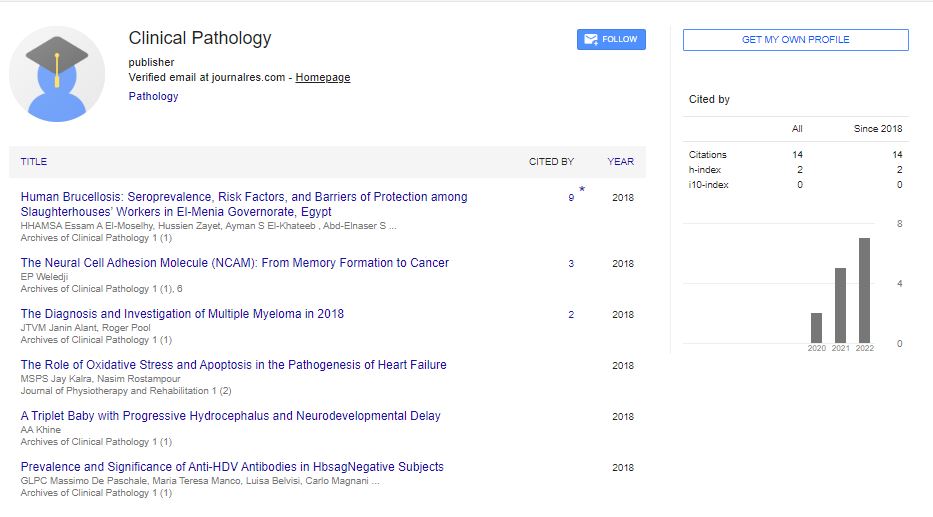Opinion Article, Arch Clin Pathol Vol: 6 Issue: 4
Investigative Techniques in Forensic Pathology: Autopsies to Advanced Imaging
James Vincent*
1Department of Medicine, McMaster University, Hamilton, Ontario, Canada
*Corresponding Author: James Vincent,
Department of Medicine, McMaster
University, Hamilton, Ontario, Canada
E-mail: jamesvincent@uni.edu.ca
Received date: 27 November, 2023, Manuscript No. ACPY-24-124241;
Editor assigned date: 30 November, 2023, PreQC No. ACPY-24-124241 (PQ);
Reviewed date: 13 December, 2023, QC No. ACPY-24-124241;
Revised date: 21 December, 2023, Manuscript No. ACPY-24-124241 (R);
Published date: 28 December, 2023 DOI: 10.4172/acpy.100105
Citation: Vincent J (2023) Investigative Techniques in Forensic Pathology: Autopsies to Advanced Imaging. Arch Clin Pathol 6:4.
Description
Forensic pathology stands as a critical discipline at the intersection of medicine and law, dedicated to unraveling the circumstances, causes, and mechanisms of death. This specialized field applies principles of pathology, anatomy, and medical science to investigate deaths of medico-legal significance. Fundamentals of forensic pathology
Forensic pathologists investigate deaths occurring under sudden, unexpected, suspicious, or unnatural circumstances. Their role involves performing autopsies to ascertain the cause, manner, and time of death. The cause of death refers to the disease, injury, or circumstance leading to death, while the manner of death classifies it as natural, accident, homicide, suicide, or undetermined.
Autopsy examination involves a systematic approach, examining external findings, injuries, and internal organs through dissection, radiography, and histological analysis. Forensic pathologists collect evidence, document injuries, and perform toxicological analyses to ascertain the presence of drugs, poisons, or toxins.
Methodologies in forensic pathology
Forensic pathology utilizes a range of investigative techniques to determine the cause and manner of death. External examination involves documenting injuries, wounds, or marks on the body, assessing their characteristics, patterns, and significance. Internal examination includes detailed organ inspections, collecting specimens for histological and toxicological analyses, and preserving evidence for further testing.
Toxicological analyses involve testing blood, urine, or tissue samples for the presence of drugs, alcohol, poisons, or toxic substances. Additionally, radiological examinations, such as X-rays or CT scans, aid in identifying fractures, foreign bodies, or pathological changes within the body.
Role in legal investigations
Forensic pathologists play a crucial role in legal investigations, providing expert opinions and testimony in court proceedings. Their findings and conclusions assist law enforcement agencies, attorneys, and the judiciary in criminal and civil cases. The forensic autopsy report serves as a critical document, detailing the examination findings, conclusions, and expert opinions.
The forensic pathologist's testimony elucidates the circumstances surrounding death, injury patterns, cause of death, and the correlation between injuries and events leading to death. Their expertise aids in elucidating criminal intent, determining liability, and achieving justice in legal proceedings.
Emerging trends and innovations
Advancements in forensic pathology continue to refine investigative techniques and enhance accuracy in determining causes of death. Molecular and genetic analyses provide insights into genetic predispositions, identifying familial diseases, or determining paternity in cases involving unidentified or deceased individuals.
Virtual autopsies, utilizing advanced imaging technologies like CT or MRI scans, complement traditional autopsies and aid in examining bodies without invasive procedures. Additionally, advancements in forensic entomology, studying insect activity on decomposing bodies, offer insights into postmortem intervals and environmental conditions at the time of death.
Challenges and future directions
Forensic pathology faces challenges such as resource limitations, backlogs in case examinations, and the need for specialized training and facilities. Maintaining quality standards and ensuring the preservation of evidence during autopsies are crucial for accurate determinations.
The future of forensic pathology involves embracing technological innovations like Artificial Intelligence (AI) for image analysis and data interpretation, promoting interdisciplinary collaborations, and establishing standardized protocols. Continuous education and training programs are essential for maintaining expertise and addressing evolving challenges in forensic investigations.
Conclusion
Forensic pathology remains pivotal in uncovering truths behind deaths and providing critical evidence for legal proceedings. Its methodologies, from meticulous autopsies to advanced investigative techniques, continue to evolve, guiding legal investigations and justice delivery. With ongoing technological advancements and collaborative efforts, forensic pathology enhances in investigative accuracy and contributing to the fair administration of justice in society.
 Spanish
Spanish  Chinese
Chinese  Russian
Russian  German
German  French
French  Japanese
Japanese  Portuguese
Portuguese  Hindi
Hindi 